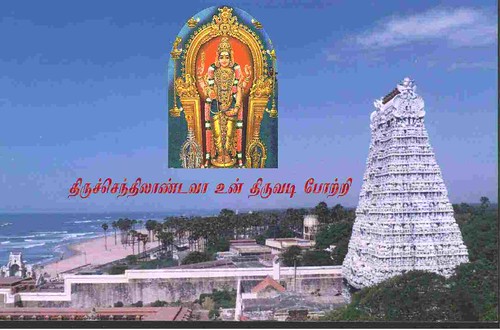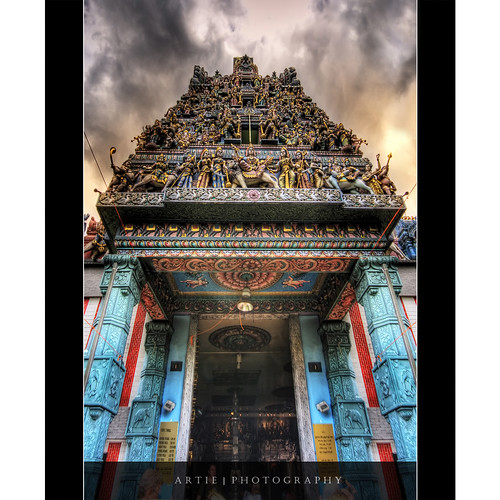Thiruchendur Lord Murugan Temple (Thiruchendur Senthilandavan Koil) is one of the six major abodes of Lord Muruga, who is worshipped here by also other names such as Senthilandavan and Senthilkumar. Lord Murugan is also known as Subrahmanya, Karthikeya, Kumaran, Skanda, Saravana, Shanmukha, Arumugan, Swaminatha and many other names. Similarly, Thiruchendur is also referred to by other names as Thirucheeralaivai, Thiruchenthil and Thiruchenthiyoor. The temple is situated so close to the sea that the waves lap at the eastern boundary wall of the temple.
The other five major abodes of Lord Muruga are at Palani (120 km west of Madurai), Swamimalai (150 km east of Madurai), Thiruthani (50 km from Chennai), Pazhamudircholai (10 km north of Madurai) and Thiruparamkunram (10 km south of Madurai). Each of the six major abodes of Lord Muruga has an event mentioned in the Hindu scriptures, of which Tiruchendur is said to be second in importance.
There is an account of Karthikeya's origin in the Mahabharata, in which he is said to have been born of Agni and Shiva, after Shiva impersonated six of the seven wives of the Saptarishi (Seven Sages). The Ramayana also has a version of him, closer to the stories told in the Puranas.
Atharva Veda describes Kumaran as Agnibhuh (son of Agni, the fire god). The Chandogya Upanishad refers to Skanda as the ‘way that leads to wisdom’. The Baudhayana Dharmasutra mentions Skanda as 'Mahasena' and 'Subrahmanya.' The Aranya Parva chapter of the Mahabharata narrates the legend of Kartikeya Skanda. The Skanda Purana is devoted to the narrative of Kartikeya.
Also there are references to Subrahmanya in Kautilya's Arthashastra, in the works of Patanjali, in Kalidasa's epic poem the Kumarasambhavam and in the Sanskrit drama Mricchakatika.
According to legends, Sati, the consort of Shiva immolated herself at the Daksha Yagna, which was later destroyed by Shiva. Sati was reborn as Uma (or Parvati) the daughter of the Mountain King Himavaan (the Himalayas). Shiva was deep in yogic meditation in the Himalayas. During that time, the demon Surapadman ravaged the earth and tormented its beings. The gods realized that only a son born of Shiva could lead them to victory over Tarakasuran, Surapadman and their demon armies. The gods plotted with Kamadeva, the god of love, to shoot a flower arrow at the meditating Shiva, so as to make him fall in love with Parvati. When Kama aimed his arrow, Shiva opened his third eye and burned Kama to ashes instantly.
The sparks of the fiery seed of Shiva were unbearable, and this fire was then transported by the river Ganga into the Saravana forest (probably The Sundarbans), and into a pond called the Saravana Poigai, located at mouths of river Ganga, where the sparks transformed to six children. They were raised by the six Krittika or Kartika - the stars that make up the Pleiades, earning Murugan the name Karthikeya. Parvati combined these six babies into one with six faces (Shanmukha or Arumugan).
Murugan became the supreme general of the gods and lead the army of the gods to victory against the demons. The six sites at which Karthikeya sojourned while leading his armies against Surapadman are Thiruthani, Swamimalai, Tiruvavinankudi (Palani), Pazhamudircholai, Thiruparamkunram and Tiruchendur. These six sites are known collectively as ‘Arupadai Veedu, meaning the six battle camps of the Lord.
Thiruchendur Murugan Temple is a very popular pilgrimage center and tourist destination. It located in the town of Thiruchendur in the district of Tuticorin, Tamil Nadu, India. It is 55 km southeast of Tirunelveli, 40 km from Tuticorin and 75 km northeast of Kanyakumari. It is easily accessible by bus or car. Regular train services are available to Tiruchendur from the nearest railway junction, Tirunelveli Junction.








